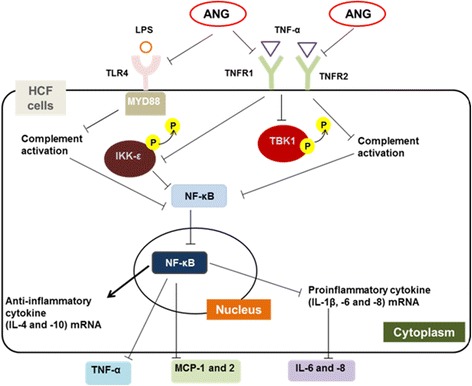Fig. 8.

Schematic model illustrating the signaling pathway by which angiogenin (ANG) reduces the inflammatory responses involving TANK-binding kinase (TBK)1- and IkappaB kinase-epsilon (IKK-ε)-mediated nuclear translocation of nuclear factor-kappaB (NF-κB) in tumor necrosis factor-alpha (TNF-α)- or lipopolysaccharide (LPS)-induced inflammatory human corneal fibroblasts (HCFs). ANG down-regulates the mRNA expression of pro-inflammatory cytokines (interleukin [IL]-1β, IL-6 and IL-8) and up-regulates the mRNA expression of anti-inflammatory cytokines (IL-4 and IL-10). ANG suppresses the nuclear translocation of NF-κB through the inhibition of TNF-α receptor (TNFR)1 and TNFR2 mRNA expression and TBK1 production in TNF-α-induced inflammatory HCFs. ANG also reduces NF-κB nuclear translocation through a reduction in toll-like receptor (TLR)4 and myeloid differentiation primary response gene (MYD)88 mRNA expression and IKK-ε expression in LPS-induced inflammatory HCFs. The cascade underlying the effect of ANG results in a suppression of inflammatory cytokines and chemokines such as TNF-α, monocyte chemotactic protein (MCP)-1, MCP-2, IL-6 and IL-8
